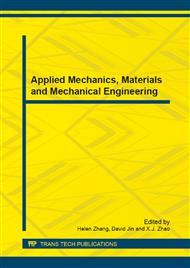[1]
Gillespie, T. D., Fundamentals of Vehicle Dynamics, Society of Automotive Engineers Inc., (1992).
Google Scholar
[2]
The Bose Suspension System-Resolving the conflict between comfort and control, Bose Learning Center, 2008. http: /www. bose. com/controller?event=VIEW_STATIC_PAGE_EVENT&url=/learning/project_sound/suspension_components. jsp.
Google Scholar
[3]
Shen, Y., Golnaraghi, M. F. and Heppler, G. R., Load-leveling suspension system with a magneto-rheological damper, Vehicle System Dynamics, Vol. 45, No. 4, pp.297-312, (2007).
DOI: 10.1080/00423110600928721
Google Scholar
[4]
Xiaojie Wang and Faramarz Gordaninejad, Flow Analysis and Modeling of Field-Controllable, Electro- and Magneto-Rheological Fluid Dampers, Journal of Applied Mechanics, Vol. 74 / 13, (2007).
DOI: 10.1115/1.2166649
Google Scholar
[5]
C. Shivaram and K.V. Gangadharan, Statistical modeling of a magnetorheological fluid damper using the design of experiments approach, Smart Materials And Structures Smart Mater. Struct., 16, p.1310–1314, (2007).
DOI: 10.1088/0964-1726/16/4/044
Google Scholar
[6]
Ping Yang, Ninbo Liao, Jianbo Yang, Design, test and modelling evaluation approach of a novel Si-oil shock absorber for protection of electronic equipment in moving vehicles, Mechanism and Machine Theory, Volume 43, Issue 1, Pages 18-32, (2008).
DOI: 10.1016/j.mechmachtheory.2007.06.001
Google Scholar
[7]
Zekeriya Parlak, Tahsin Engin, İsmail Çallı, Optimal design of MR damper via finite element analyses of fluid dynamic and magnetic field, Mechatronics, Volume 22, Issue 6, Pages 890-903, September (2012).
DOI: 10.1016/j.mechatronics.2012.05.007
Google Scholar
[8]
Dinh Quang Truong, Kyoung Kwan Ahn, Nonlinear black-box models and force-sensorless damping control for damping systems using magneto-rheological fluid dampers, Sensors and Actuators A: Physical, Volume 167, Issue 2, Pages 556-573, June (2011).
DOI: 10.1016/j.sna.2011.02.048
Google Scholar
[9]
Fengchen Tu, Quan Yang, Caichun He, Lida Wang, Experimental Study and Design on Automobile Suspension Made of Magneto-Rheological Damper, Energy Procedia, Volume 16, Part A, Pages 417-425, (2012).
DOI: 10.1016/j.egypro.2012.01.068
Google Scholar
[10]
Fitrian Imaduddin, Saiful Amri Mazlan, Hairi Zamzuri, A design and modelling review of rotary magnetorheological damper, Materials & Design, Volume 51, Pages 575-591, October (2013).
DOI: 10.1016/j.matdes.2013.04.042
Google Scholar
[11]
Francesc Pozo, Mauricio Zapateiro, Leonardo Acho, Yolanda Vidal, Ningsu Luo, Experimental study of semiactive VSC techniques for vehicle vibration reduction, Journal of the Franklin Institute, Volume 350, Issue, Pages 1-181, February (2013).
DOI: 10.1016/j.jfranklin.2012.11.008
Google Scholar
[12]
Duym, S. Stiens, R. and Reybrouck, K., Evaluation of Shock Absorber Models, Vehicle System Dynamics, 27, 1997, pp.109-127.
DOI: 10.1080/00423119708969325
Google Scholar
[13]
Bathe, K. J. Zhang, H. and Ji, S., Finite element analysis of fluid flows fully coupled with structural interactions, Computers & Structures, 72(1-3), 1-16, (1999).
DOI: 10.1016/s0045-7949(99)00042-5
Google Scholar
[14]
Beghi, A. Liberati, M. Mezzalira, S. and Peron, S., Grey-box modeling of a motorcycle shock absorber for virtual prototyping applications, Simulation Modeling Practice and Theory, 15(8), pp.894-907, (2007).
DOI: 10.1016/j.simpat.2007.04.011
Google Scholar
[15]
Koji Moriya, Takashi Kawabuchi, Kiyoshi Ioi, Atsushi Suda, Masahiko Yamamoto, Dynamic Analysis of Wagon Caster With Shock Absorber, SICE Annual Conference 1250-1254.
Google Scholar


